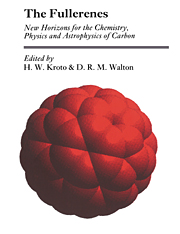Book contents
- Frontmatter
- Contents
- The evolution of the football structure for the C60 molecule: a retrospective
- Dreams in a charcoal fire: predictions about giant fullerenes and graphite nanotubes
- On the formation of the fullerenes
- Production and discovery of fullerites: new forms of crystalline carbon
- Systematics of fullerenes and related clusters
- The fullerenes: powerful carbon-based electron acceptors
- The carbon-bearing material in the outflows from luminous carbon-rich stars
- Elemental carbon as interstellar dust
- The pattern of additions to fullerenes
- Pollyynes and the formation of fullerenes
- Hypothetical graphite structures with negative gaussian curvature
- Fullerenes as an example of basic research in industry
- Deltahedral views of fullerene polymorphism
- Geodesic domes and fullerenes
On the formation of the fullerenes
Published online by Cambridge University Press: 03 February 2010
- Frontmatter
- Contents
- The evolution of the football structure for the C60 molecule: a retrospective
- Dreams in a charcoal fire: predictions about giant fullerenes and graphite nanotubes
- On the formation of the fullerenes
- Production and discovery of fullerites: new forms of crystalline carbon
- Systematics of fullerenes and related clusters
- The fullerenes: powerful carbon-based electron acceptors
- The carbon-bearing material in the outflows from luminous carbon-rich stars
- Elemental carbon as interstellar dust
- The pattern of additions to fullerenes
- Pollyynes and the formation of fullerenes
- Hypothetical graphite structures with negative gaussian curvature
- Fullerenes as an example of basic research in industry
- Deltahedral views of fullerene polymorphism
- Geodesic domes and fullerenes
Summary
The chemistry by which the closed-cage carbon clusters, C60 and C70, can be formed in high yield out of the chaos of condensing carbon vapour is considered. Several mechanisms for this process that have been proposed are critically discussed. The two most attractive are the ‘pentagon road’ where open sheets grow following the alternating pentagon rule and the ‘fullerene road’ where smaller fullerenes grow in small steps in a process which finds the buckminsterfullerene (C60) local deep energy minimum and to a lesser extent the C70 (D5h) minimum. A clear choice between the two does not seem possible with available information.
Introduction
The observation (Kroto et al. 1985) that the truncated icosahedron molecule, CBF60 (buckminsterfullerene), is formed spontaneously in condensing carbon vapour was greeted by some in the chemical community with some doubt. It seemed incredible that this highly symmetrical, closed, low entropy molecule was forming spontaneously out of the chaos of condensing high-temperature carbon vapour. We still believe that the formation of CBF60 in supersonic cluster beam sources must be a relatively minor channel, probably accounting for less than 1% of the total carbon. Thus when CBF60F was finally isolated from graphitic soot (Krätschmer et al. 1990), it came as a surprise that the CBF60 plus C70 yields were as large as 5%. Later yields have improved substantially, for example Parker et al. (1991) obtained a total yield of CBF60 of about 20% with total extractable fullerene yields totalling 44% from a carbon arc soot. Thus conditions can be found where CBF60 and fullerene formation in carbon condensation can hardly be called a minor channel.
- Type
- Chapter
- Information
- The FullerenesNew Horizons for the Chemistry, Physics and Astrophysics of Carbon, pp. 19 - 32Publisher: Cambridge University PressPrint publication year: 1993
- 3
- Cited by

